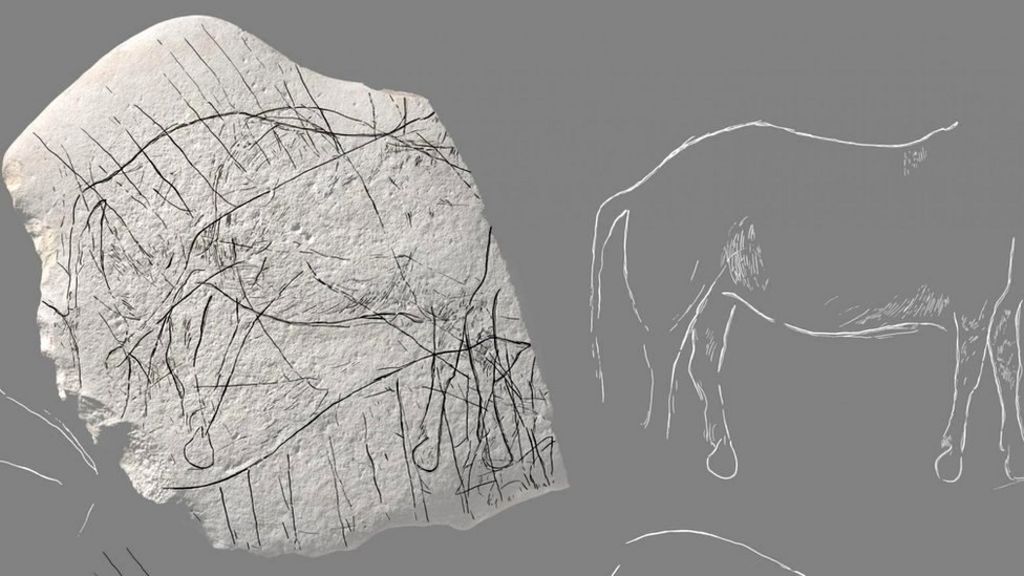
Side face of the sandstone block. (Denis Gliksman, Inrap)

Drawings on the stone block. (Denis Gliksman, Inrap)
Posted on 06/06/2019 4:12:46 PM PDT by ETL
Archaeologists in France have uncovered a mysterious carved stone block at a prehistoric hunting site.
The stone was found during excavations at Angouleme in southwestern France.
A number of engravings have been carved into the sandstone, including horses, deer and an aurochs, an extinct species of wild cattle.
“The most visible engraving, that of a headless horse turned to the right, occupies half the surface,” according to a translated statement from French national archeological research organization Inrap.
“The rump and the saddle follow the curves of the natural edge of the stone. Very fine incisions may suggest the coat”.
The area where the stone was found was used as a hunting site by the prehistoric Azilian culture.
Other items discovered at the site include tools for stripping carcasses.
Experts think that the stone is about 12,000 years old.
More research will be done to precisely date and gain more information from the artifact.
Other mysterious stones have been grabbing attention in France.
A village in Brittany, for example, recently offered a reward to anyone who can decipher a strange inscription on a centuries-old rock.
(Excerpt) Read more at foxnews.com ...


Drawings on the stone block. (Denis Gliksman, Inrap)
What does it say? What language is that?
Brother Maynard, you're our scholar.
It is Aramaic!
Of course. Joseph of Arimathea!
Of course.
What does it say?
It reads,
"Here may be found...
"...the last words of Joseph of Arimathea:
"He who is valiant and pure of spirit...
"...may find the Holy Grail...
"...in the Castle of Aaargh."'
What?
"The Castle of Aaargh."
What is that?
He must have died while carving it.
Come on!
That's what it says.
Look, if he was dying,
he wouldn't bother to carve "Aaargh."
He'd just say it.
That's what's carved in the rock.
Perhaps he was dictating it.
Shut up!
Does it say anything else?
No!
Just "Aaargh."
_____________________________________________________
Here's the clip on YouTube...
This land is posted.
Easy!
Everyone knows that it’s a recipe for Horse Meat Stew. ;)
Anyone who isn’t an idiot can see that is Tyrannosaurus Rex.
*ping*

and a justification for the thousands of grant dollars awarded to the archaeologist.
I don’t mean to start something, but you ever notice how the rock art of 12000 year ago Europeans look far more advanced than 1000 year old rock art of the American Indian?

It sounds like those cattle are similar to the Gaur which is still around.
Does it say ‘beer’ on it?

It is the ancestor of domestic cattle; it has also been suggested as an ancestor genetically to the modern European bison, which have been crossbred with steppe bison.[2]
The species survived in Europe until 1627, when the last recorded aurochs died in the Jaktorów Forest, Poland.
During the Neolithic Revolution, which occurred during the early Holocene, at least two aurochs domestication events occurred: one related to the Indian subspecies, leading to zebu cattle, and the other one related to the Eurasian subspecies, leading to taurine cattle.
Other species of wild bovines were also domesticated, namely the wild water buffalo, gaur, wild yak and banteng.
In modern cattle, numerous breeds share characteristics of the aurochs, such as a dark colour in the bulls with a light eel stripe along the back (the cows being lighter), or a typical aurochs-like horn shape.[3]
Scientists are currently applying back-breeding genetic techniques to modern cows containing applicable DNA in order to restore the auroch — a massive bovine renowned in ancient history.

The auroch is the ancestor of modern domesticated species of zebu and taurine cows.
They were 7ft tall, weighed more than 2,000 lbs, and formerly roamed extensive expanses across the marshlands and forests of the eastern hemisphere until their complete extinction in the early 1600s.
There is an imminent need for large bovine animals in current grazing ecosystems due to their ability to retain large, healthy grazing areas compared to the smaller, agriculturally developed cows of today.
The provision of environmental stability comes equipped with an element that would assist people as well.
Promoting a distinct attraction within the wildlife tourism industry would create economic growth in applicable areas and increase the viability of rural communities.
The first complete genome of an auroch was sequenced in 2015 from the fossil of a humerus bone.
This information has been implemented into Operation Tauros, which has identified a group of the most closely related modern cows with the purpose of recreating the auroch through selective breeding.
Animals used in the program are chosen from primitive European heritage herds and selected for genetic similarity, then bred through multiple generations with the intent of restoring the auroch phenotype.
Although without genetic engineering the genotype will be impossible to revive, scientists aim to achieve an animal as close as possible to the impressive ancient auroch.
The project began in 2009 and has since been immensely successful, resulting in the birth of 300 calves in specified breeding sites around Europe.

The Indian aurochs (Bos primigenius namadicus) was a subspecies of the extinct aurochs.
It is considered the wild ancestor of the domestic zebu cattle, which is mainly found in the Indian subcontinent and has been introduced in many other parts of the world, like Africa and South America.
In contrast, the domesticated taurine cattle breeds, which are native to Europe, the Near East, and other parts of the world, are descendants of the Eurasian aurochs (Bos primigenius primigenius).
According to IUCN, the Indian aurochs disappeared before the 13th century AD, when the only subspecies standing was Bos primigenius primigenius whose range was by then restricted to Europe.[1]
The wild population of Indian aurochs was likely extinct millennia earlier than that; the most recent skeletal remains, from Uttar Pradesh, date from around 1,800 BC.[2]
My current work ain’t any better, either.
Didn’t Tacitus mention a tax rebellion in which the Gauls asked if their taxes, in cow skins, were to be the domestic cow, or the wild cows (Aurochs). The tax man said the larger wild cow, and the people rebelled.
Can’t make out a fricking thing.
Disclaimer: Opinions posted on Free Republic are those of the individual posters and do not necessarily represent the opinion of Free Republic or its management. All materials posted herein are protected by copyright law and the exemption for fair use of copyrighted works.